Mid October and a fairly big tide, weather half decent (for the UK !)… it had to be a kayak fishing trip to North Devon. I wanted to put the new Conoflex Jedi Kayak QT fishing rod to the test and see what it could really handle. A few triggerfish would be just the ticket and maybe even the outside chance of a tope !
I met up with Adam quite early, conditions looked okay, but not as good as the day before. James (overrun) had gone out on Saturday – and the water was perfect – he caught a huss and a smoothound. My car was in the garage that day, otherwise I would have joined him !
As we paddled out of the bay, I switched the Humminbird side imaging unit on, and started to record some sonar tracks. The ground was a mixture of sand and flat rock. The image below was generated using Sonar TRX and allows you to superimpose your sonar images in Google Earth.
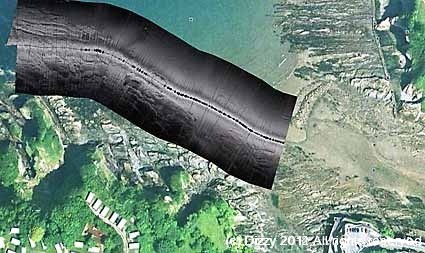
As you can see, the ground we were paddling over (at high tide) was a continuation of the rocks and sand visible in Google Earth (the GE aerial images were taken at low water).
As myself and Adam were paddling, we were getting alot of fish returns on the fish finders. These were not big fish, but they were tightly packed – my guess is sprats or herring. Adam later saw a harbour porpoise, so maybe that is what they were feeding on.
We paddled out to a mark where we had caught triggerfish before, there are a group of rock pinnacles which rise up abruptly from the sea bed – unfortunately, the strong tide and breeze conspired to make it very difficult to anchor or fish – it would have been very uncomfortable. So we decided to go on a bit of an explore and see if we could use the side imaging sonar to locate some new kayak fishing marks.
We paddled towards a headland a couple of kilometers away. Most of the sea bed was sand – but there were a couple of patches of rock and broken ground, I shouted to Adam, and he marked them on the GPS.
We had both put the rods out and were trolling a set of small feathers – absolutely nothing was biting. As we neared the headland, the swell got up again so for the second time, we had to look for a new spot to fish. We plotted a course to intersect the area of rock and broken ground we had scanned earlier – this time, I went straight over with the side imaging recording the whole thing. We made a couple of drifts to check wind and tide and then a final one to try to anchor in the middle of the rough ground.
You can see from the image below, the ridges of rock poking out above the sand on the sea bed…

The numbers show where we were anchored – the tide and wind were moving around a bit.
I decided to split my tactics – a fillet of bluefish on an 8/0 hook and wire trace on the heavy Maxximus rod, and a 2 hook paternoster with small hooks on the light Conoflex QT rod. To be honest, given the ground we were over – I thought that it was more likely that the big bait would score with a huss dogfish or tope…. How wrong I was !
I had just cast out the scratching rig baited up with peeler crab (hoping for a triggerfish) and was baiting up the big rod, when I noticed out of the corner of my eye that the Conoflex QT rod was bent double and in danger of being pulled out of the rest. The tide was ebbing quite hard and I wondered if it had picked up a ball of weed, but when I picked up the rod, I could clearly feel the weight of a decent fish on the other end of the 12lb line.
I shouted to Adam, and started to try to gain some line – I had no idea what was on the other end – but my mind was daring to think it might be a really big trigger fish. I had to take the fight relatively easy – because I was using very light gear and size 1 hooks. I would gain a few yards of line and then the fish would peel yards of line from the Shimano Calcutta 400 baitcaster. All thoughts of a triggerfish had now gone, and ever the optimist I started to wonder if I had spawned out another double figure bass or maybe even a small tope.
The fight continued, a real scrap – the yellow tip of the QT was dragged under the water a number of times – this was an amazing fight by anyone’s standards. Finally, I managed to catch a glimpse of the fish – it was a smoothound ! Probably about 8lbs, but it did not want to hang around and made another couple of runs before I could get it close enough to the kayak to lift it aboard.
Once on the kayak, the starry smoothound proceeded to go crazy and thrash around like a thing posessed. It wrapped its rough sandpaper like scales across my hand and rasped the skin off – OUCH !
Once I had composed myself – I took some pictures – Adam had come over to see what the fuss was about, he took some pictures and anchored a bit closer – a sensible move as it turned out.
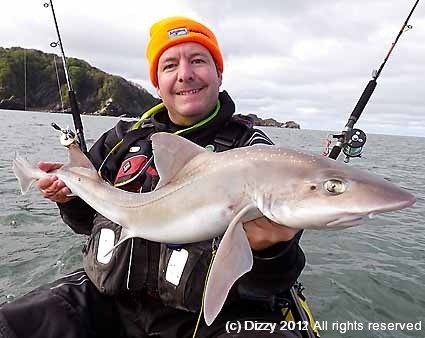
As you can see from the picture – this was my first cast at our new spot – and I had not even had time to cast out the other rod !
The fish was safely released and both rods were cast back out. For the next few hours, the action was pretty much continuous – all of the fish were falling to the small crab baited hooks – not a single fish to the big bait (apart from a short run – probably a dogfish).
The next fish was a nice sized ballan wrasse – great fish which are very tough…
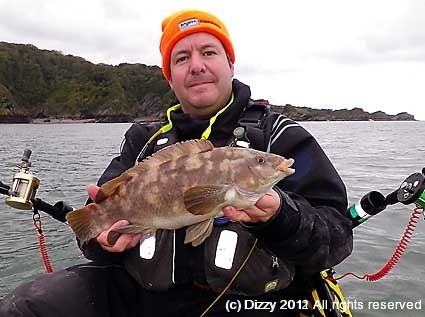
Then a rockling (a first for me from the kayak)…

Then an eel (sorry, no photo), and then a double shot of pouting – don’t laugh !

Adam was also pulling in the fish – he had a pouting, a nice pollack and a smoothound – all on feathers baited with squid strip !
Here are some pictures of him fighting the smuts…
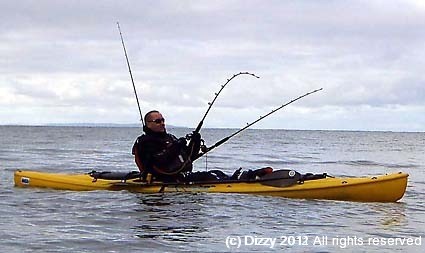
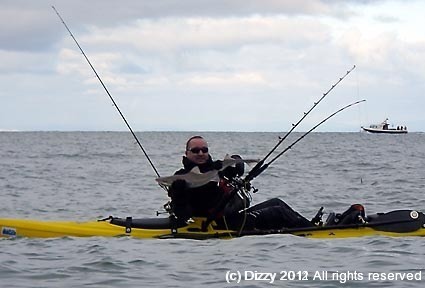
The smoothound runs seemed to be getting more numerous and the fish were also getting bigger… I don’t know how many smuts we had; easily 4 or 5 – all of mine were starries, but Adam had a common and we both had double figure fish too – a great haul. This is my favourite photo…
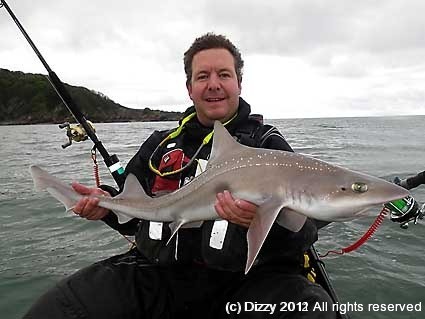
There is something very satisfying about catching so many great fish on a new mark close inshore and on such sporting tackle – 99.9% of fishermen pass by this mark on their way out to deeper water – it just shows what can be achieved with some like minded friends, electronics, and a 15 foot piece of floating plastic – kayak fishing…. Its the future !
I have put together a video of the day’s events – if you enjoy it, please leave a cooment and subscribe to my Youtube channel…
[vsw id=”64HsISYgBCM” source=”youtube” width=”425″ height=”344″ autoplay=”no”]

Wow what a catch, sounds a great day. 😀
WOW great photos…..I wanted to ask you about the hummingbird fish finder. I’m thinking about buying a 798 with SI……
1) how did you mount your SI transducer?
2. Did you consider mounting it inside the kayak and shooting the beam thru the hull?
3. Is the 5″ screen on the 798 to small for SI imaging?
Thanks,
Charlie
Bethlehem, Pennsylvania, USA
Hi Charlie – I am glad you like the photos. I mounted the transducer for the Humminbird 987 on a DIY swinging arm…
At the time conventional wisdom said you couldn’t mount a side imaging ttransducer inside the hull. But since then, a couple of people have proved that you can install a side imaging transducer in the hull of the kayak (with a bit of know how and some sikaflex)…
The screen on the 798 is just about ok, to be honest even on a 9 inch screen, it is sometimes difficult to pick things out. Try recording your side imaging footage to an SD card when you are on the water and then take a closer look at it using free software such as Humviewer or SIView when you get home.
Does that help ?
Ian
Hi Dizzy
I am chairman of Combe Martin Tourism Association, and we would love to include your video and maybe a few pictures of you fishing in our bay, next time you are coming to Combe Martin please let us know as we would love to meet you
kind regards Gary
Hello Ive just bought a kayak and I would like some advice on what to wear. Are chest waders better or leggings and wellies or sock chest waders. any advice.
Ivan – Safety is really important – I wuld recomend a dry suit, and a PFD (Personal Floatation Device) as well as a VHF radio – but its no good getting the gear… you really need to go on a safety course to learn how to use it all. Have a look at my free guide… http://dizzybigfish.co.uk/free-guide-to-kayak-fishing/